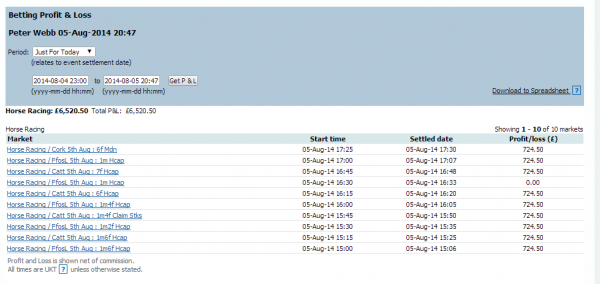Peter’s laying system
Slightly tongue in cheek title – If there’s one mistake I’ve made in my time in the markets it’s not sticking my name on a concept. As a consequence there are a lot of phrases out there that most probably originated from this camp but are now in general use. Therefore I’m probably the ‘hoover’ of the Betfair trading world, the ‘biro’ the ‘sellotape’. To be fair this happens to everybody who is a pioneer so a also tip my hat to the many people that were around in the early 2000’s who also put their money on the line and helped forge a path for us all.
On this note, It’s curious to see how some things come to the fore, you can’t really predict it. ‘Lay the draw’ is one of the most popular searched phrases despite its many flaws. Lay the field, Maria’s laying system, slicers bet, to name a few popular terms, not mine, that have come out of the woodwork over the years. I guess everybody is a sucker for a golden bullet.
So I’d like to introduce Peter’s laying system. Actually I won’t, as I haven’t finished it just yet. But it points out a couple of serious notes.
Tiny over-round’s mean little is lost in modern gambling markets
First, it’s interesting to see how the book % is getting so close to 100% nowadays. I’m increasingly playing with systems that exploit this. What’s the significant of when the book % get towards 100%? Well, in theory at least at 100%, you are losing no money to anybody in the long term at a gross level, so that has to be appealing. For a couple of years now I’ve deployed dutching strategies that exploit this. But I’ve also turned my attention to outright backing and laying systems. Curiously these don’t exploits statistics as such, just anomalies in peoples thinking. People tend to back or lay too quickly at certain points in a market. Triggering a bet at this point when the book is near 100% means you have the best possible chance of profiting.
Basically I know that if the market is efficient then laying into a 100% book should achieve break even over time. But how can the market be efficient when the same horse trades at both 3.00 and 4.00 before the start of the race? Spotting when this is anomalous gets me a lay at a cheap price.
So looking for a sharp deviation from what could be considered a ‘normal’ price they laying it when the least amount can be lost, in theory, to the other side of the book is a really good system. That is the basis of the this process. Place a value bet when there is little lost to the other side. Even if its not value in the long run it will break even.
Misleading screenshot
But its a balance of probabilities and this is why my screenshot is misleading. But the amusing thing is my success rate yesterday. I picked on 10 afternoon races looking for an outright lay opportunity, bailed one for zero, basically I changed my mind, but the rest were all winners. Today though could be a different kettle of fish, but it’s unlikely that I will have all losers or losses that exceed yesterdays, so I should be up over two days.
If you want some maths behind the lays here it is: –
The average lay price was 5.86. If you lay at 6 you have a 16.67% chance of that lay losing. So if we work out the probability of a ‘not lose’ it comes in at 83%. So nine ‘not loses’ at our average lay price comes in at around a 17% chance of occurring and would occur at a rate of about one in six days. So despite the rather crunchy result, you can see it wouldn’t take long for a reversion to mean(ish). So that in a nutshell is ‘Peter’s’ laying system.
To capture the exact moment that the market is close to most efficient I use automation to trigger my bet. I can’t possibly do that manually so Bet Angel automation gives me that ability.
So, if you are looking for value I reckon capturing it at the optimal moment, excluding trading, will probably give you the edge if you are looking for in outright back or lay strategy.
![]()
Category: Trading strategies






